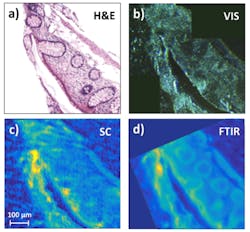G&H MINERVA project completes; adds mid-IR spectral tools to medical diagnosis
Gooch & Housego (G&H; Ilminster, England) announced that the European FP7 project MINERVA (MId- to NEaR infrared spectroscopy for improVed medical diAgnostics), which was funded by the European Commission through its Seventh Framework Programme (FP7), has now completed. Coordinated by G&H, the project brought together 13 partners from across Europe with the common objective of developing mid-infrared (mid-IR) technology based on supercontinuum sources (SCSs) to improve the early diagnosis of cancer.
RELATED ARTICLE: Moving toward MIR optical biopsy
The MINERVA system measures absorption peaks in the mid-IR range, allowing for analysis of a wide variety of biological constituents, such as fats, proteins, and DNA. This region of the spectrum offers exciting possibilities for real-time molecular-sensing, for example in medicine and healthcare (such as early cancer detection: the MINERVA application space), environment and energy (monitoring exhaust gases) and security (detection of narcotics or explosives; food security). In particular it has been shown that, through the latest data analysis techniques, this spectral region can be used to identify the presence of early cancer (see image).
Histological features can be resolved using a simplified MINERVA system. With the addition of IR cameras and acousto-optic tunable filters (AOTFs) the performance can be expected to increase significantly.
MINERVA has developed fiber, lasers and broadband sources, components, modulators and detectors to access this important part of the spectrum. In parallel it has identified analytical techniques using the new photonic hardware that could help to improve early skin cancer diagnosis and the rapid automatic assessment of biopsy samples using a microscope.
Advances include chalcogenide fibers for infrared transmission and supercontinuum generation, first-ever single-mode ZBLAN fused fiber coupler, various AOTFs for the wavelength range 1.5 to 4.5 micron, the largest reported single-crystal calomel crystals (35 mm diameter), a highest-peak-power 2.9 micron laser (10.6 kW), and the longest-wavelength ZBLAN supercontinuum source, along with the first evaluation of multivariate algorithms with high spatial resolution FTIR, and human skin equivalent standardized models and algorithms for identification and differentiation of tumor cells from normal skin cells.
In addition to these scientific achievements, MINERVA has driven the introduction of new products including lasers, SCSs, acousto-optic modulators and drivers, crystal and related components and detectors for the mid-IR.
More MINERVA papers will be presented at Photonics Europe 2018 (22–26 Apr-2018; Strasbourg, France).
SOURCE: Gooch & Housego; http://marketing.goochandhousego.com/acton/rif/10079/s-01b7-1710/-/l-0013:8/l-0013/showPreparedMessage?sid=TV2:0yDdrlHoJ
About the Author

Gail Overton
Senior Editor (2004-2020)
Gail has more than 30 years of engineering, marketing, product management, and editorial experience in the photonics and optical communications industry. Before joining the staff at Laser Focus World in 2004, she held many product management and product marketing roles in the fiber-optics industry, most notably at Hughes (El Segundo, CA), GTE Labs (Waltham, MA), Corning (Corning, NY), Photon Kinetics (Beaverton, OR), and Newport Corporation (Irvine, CA). During her marketing career, Gail published articles in WDM Solutions and Sensors magazine and traveled internationally to conduct product and sales training. Gail received her BS degree in physics, with an emphasis in optics, from San Diego State University in San Diego, CA in May 1986.
